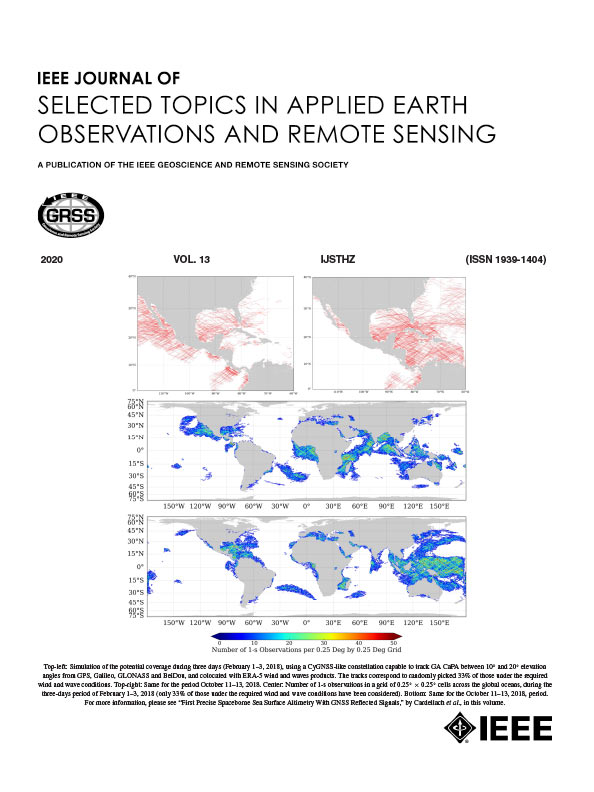用DDM-PredRNN网络跟踪预测GNSS-R延迟-多普勒地图
IF 4.7
2区 地球科学
Q1 ENGINEERING, ELECTRICAL & ELECTRONIC
IEEE Journal of Selected Topics in Applied Earth Observations and Remote Sensing
Pub Date : 2025-03-31
DOI:10.1109/JSTARS.2025.3555623
引用次数: 0
摘要
全球导航卫星系统反射测量(GNSS-R)是一种新兴的地球观测方法,它利用导航卫星的反射信号遥感物理参数,特别是探测海洋风速。然而,在许多地区,接收天线的信噪比低、增益不足等问题阻碍了可靠观测数据的获取。利用GNSS-R提供的高时间分辨率,雷达回波图像的延迟多普勒图(DDM)在序列间隔上具有内在的空间连续性和时间相关性。本文介绍了一种先进的深度学习框架DDM- predrnn,用于预测以前未观测区域的DDM。该模型采用具有PredRNN架构的时空长短期记忆网络,集成轴向注意力来捕获和利用DDM中嵌入的延迟/多普勒特征,从而增强对复杂时空特征的提取。利用气旋GNSS数据进行的实验表明,该方法可以有效地预测20步内GPS运动轨迹上的未知ddm。结果表明,DDM预测的均方根误差为1.32 dB,平均绝对误差为0.82 dB,结构相似度为0.71。该方法不仅有效解决了GNSS-R数据质量差导致的海风观测数据空白,而且填补了GNSS-R的航迹盲区。此外,预测的DDM准确反映了NBRCS在镜面点附近的变化趋势,为GNSS-R反演预测海风提供了新的视角。本文章由计算机程序翻译,如有差异,请以英文原文为准。
Trackwise Prediction of GNSS-R Delay–Doppler Maps With DDM-PredRNN Network
Global navigation satellite system reflectometry (GNSS-R) is an emerging Earth observation method that utilizes reflection signals from navigation satellites for remote sensing of physical parameters, particularly in detecting ocean wind speed. However, challenges, such as low signal-to-noise ratio (SNR) and insufficient gain of the receiving antenna have hindered the acquisition of reliable observation data in many areas. With the high temporal resolution offered by GNSS-R, the delayed-Doppler map (DDM) of radar echo images reveals inherent spatial continuity and temporal correlation across sequential intervals. This article introduces an advanced deep learning framework DDM-PredRNN for predicting DDM in previously unobserved regions. Employing a spatiotemporal long short-term memory network with a PredRNN architecture, this model integrates axial attention to capture and leverage the delay/Doppler features embedded within the DDM, thereby enhancing the extraction of complex spatiotemporal characteristics. Experiments utilizing cyclone GNSS data illustrate that the proposed method can effectively predict unknown DDMs along the GPS motion track within a 20-step timeframe. The results indicate that the root mean square error of the DDM prediction is 1.32 dB, the mean absolute error is 0.82 dB, and the structural similarity is 0.71. This approach not only effectively addresses the gaps in ocean wind observation data due to poor GNSS-R data quality but also fills the trackwise blind zones of GNSS-R. Furthermore, the predicted DDM accurately reflects trends in the NBRCS near specular point, providing a new perspective for GNSS-R retrieval forecasting of ocean wind.
求助全文
通过发布文献求助,成功后即可免费获取论文全文。
去求助
来源期刊
CiteScore
9.30
自引率
10.90%
发文量
563
审稿时长
4.7 months
期刊介绍:
The IEEE Journal of Selected Topics in Applied Earth Observations and Remote Sensing addresses the growing field of applications in Earth observations and remote sensing, and also provides a venue for the rapidly expanding special issues that are being sponsored by the IEEE Geosciences and Remote Sensing Society. The journal draws upon the experience of the highly successful “IEEE Transactions on Geoscience and Remote Sensing” and provide a complementary medium for the wide range of topics in applied earth observations. The ‘Applications’ areas encompasses the societal benefit areas of the Global Earth Observations Systems of Systems (GEOSS) program. Through deliberations over two years, ministers from 50 countries agreed to identify nine areas where Earth observation could positively impact the quality of life and health of their respective countries. Some of these are areas not traditionally addressed in the IEEE context. These include biodiversity, health and climate. Yet it is the skill sets of IEEE members, in areas such as observations, communications, computers, signal processing, standards and ocean engineering, that form the technical underpinnings of GEOSS. Thus, the Journal attracts a broad range of interests that serves both present members in new ways and expands the IEEE visibility into new areas.

 求助内容:
求助内容: 应助结果提醒方式:
应助结果提醒方式:


